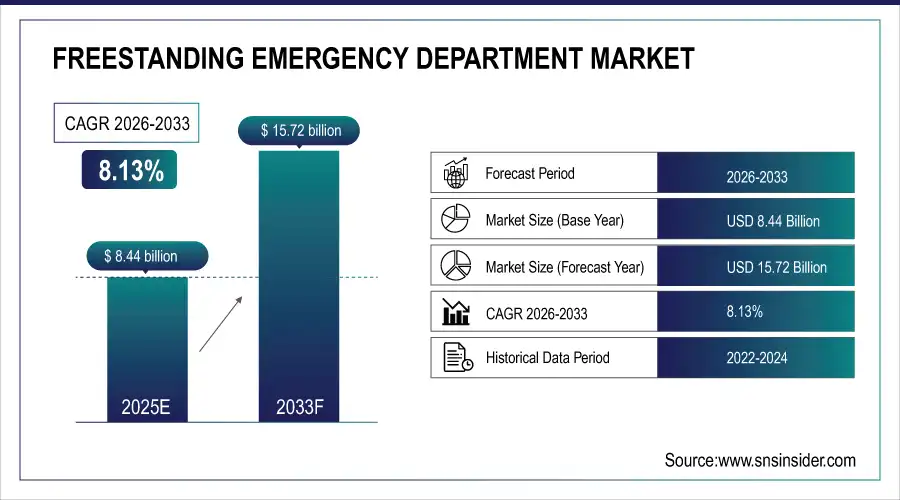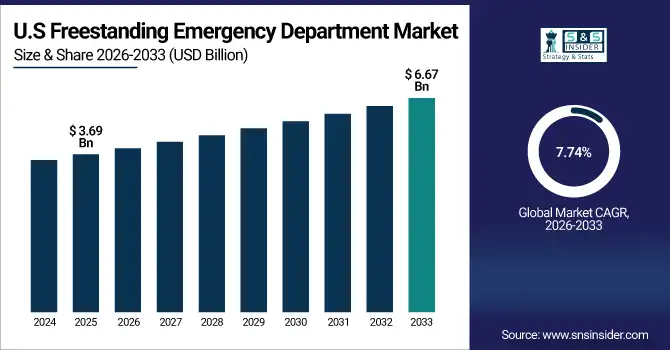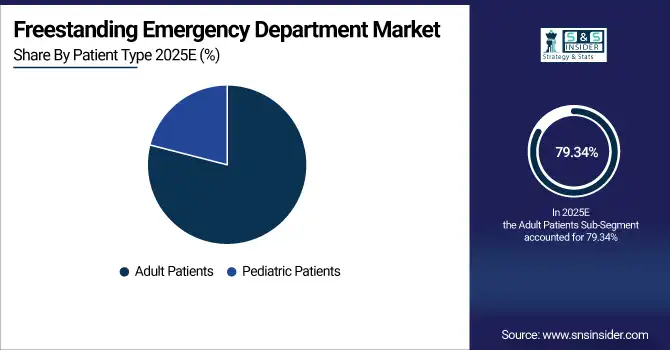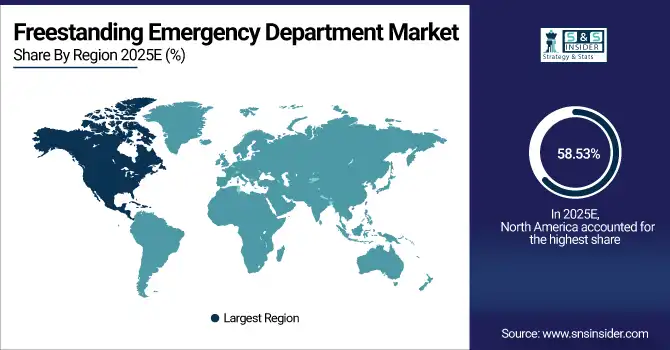Freestanding Emergency Department Market Report Scope & Overview:
The Freestanding Emergency Department Market size was valued at USD 8.44 Billion in 2025E and is projected to reach USD 15.72 Billion by 2033, growing at a CAGR of 8.13% during 2026-2033.

To Get more information On Freestanding Emergency Department Market - Request Free Sample Report
The Freestanding Emergency Department Market is growing due to rising demand for accessible, 24/7 emergency care services, increasing patient volumes in urban and suburban areas, and expanding healthcare infrastructure. Technological advancements, cost-effective treatment models, and supportive regulatory frameworks further drive market expansion and investment in decentralized emergency care facilities.
Key Freestanding Emergency Department Market Trends
-
Increasing establishment of decentralized freestanding emergency departments in urban and suburban areas to meet growing patient demand.
-
Integration of advanced diagnostic imaging, telemedicine, and point-of-care testing for faster and more efficient emergency care.
-
Expansion of FED facilities supported by favorable healthcare policies and reimbursement frameworks in developed markets.
-
Rising healthcare investments and insurance coverage driving FED growth in emerging regions such as Asia Pacific, Latin America, and MEA.
-
Adoption of AI-driven diagnostics and healthcare IT systems to improve operational efficiency and patient outcomes.
The U.S. Freestanding Emergency Department Market size was valued at USD 3.69 Billion in 2025E and is projected to reach USD 6.67 Billion by 2033, growing at a CAGR of 7.74% during 2026-2033. The U.S. Freestanding Emergency Department market is growing due to rising demand for convenient, round-the-clock emergency care, increasing patient volumes, hospital network expansions, favorable reimbursement policies, and advancements in healthcare infrastructure and diagnostic technologies.

Freestanding Emergency Department Market Growth Drivers:
-
Rising Demand and Technological Advancements Propel Global Freestanding Emergency Department Market
The global Freestanding Emergency Department market is primarily driven by increasing demand for accessible, high-quality emergency care outside traditional hospital settings. Rising patient volumes, especially in urban and suburban regions, are fueling the need for decentralized emergency services. Technological advancements in diagnostic imaging, telemedicine integration, and point-of-care testing enhance service efficiency and patient outcomes. Moreover, supportive healthcare policies and favorable reimbursement frameworks in key markets such as North America and Europe are encouraging the expansion of FED facilities. Growing awareness of time-sensitive emergency care and the convenience of reduced wait times are also motivating patients to opt for freestanding EDs over conventional hospital ERs.
In 2024, nearly 5% of admitted patients—approximately 2.3 million individuals—remained in emergency departments for 24 hours or longer during peak periods, highlighting the strain on hospital resources.
Freestanding Emergency Department Market Restraints:
-
Regulatory Challenges and Workforce Limitations Restrain Freestanding Emergency Department Market Growth
Key restraints for the Freestanding Emergency Department (FED) market include regulatory and licensing challenges across different regions, limited availability of skilled emergency care professionals, and variations in healthcare infrastructure quality. Fragmented healthcare systems and inconsistent insurance coverage can limit patient access. Additionally, patient preference for traditional hospital-based emergency care in certain regions and logistical challenges in integrating advanced IT systems may slow market adoption globally.
Freestanding Emergency Department Market Opportunities:
-
Emerging Regions Offer Major Growth Opportunities in Freestanding Emergency Department Market Through Innovation
Significant growth opportunities exist in emerging regions such as Asia Pacific, Latin America, and the Middle East & Africa, where rising healthcare investments, expanding insurance coverage, and urbanization are driving demand. Integration of advanced healthcare IT systems and AI-driven diagnostics presents opportunities for operational efficiency and improved patient care. Additionally, partnerships between private healthcare providers and governments can facilitate expansion in underserved areas, creating substantial market potential globally.
In Latin America, government and compulsory health insurance spending averages just 57% of total health expenditure, significantly below the OECD average of 74%. This reflects the higher rate of out-of-pocket spending in the region, which contributes to a two-tiered system
Freestanding Emergency Department Market Segment Analysis
-
By Service Type, Emergency Care Services dominated with 46.84% in 2025E, and Outpatient Services is expected to grow at the fastest CAGR of 9.55% from 2026 to 2033.
-
By Facility Type, Hospital-Affiliated FEDs dominated with 67.37% in 2025E, and Independent FEDs is expected to grow at the fastest CAGR of 8.64% from 2026 to 2033.
-
By Patient Type, Adult Patients dominated with 56.46% in 2025E, and Pediatric Patients is expected to grow at the fastest CAGR of 8.87% from 2026 to 2033.
-
By Patient Type, Adult Patients dominated with 79.34% in 2025E, and Pediatric Patients is expected to grow at the fastest CAGR of 8.87% from 2026 to 2033.
By Service Type, Emergency Care Services to Dominate Freestanding Emergency Department Market Outpatient Services Drive Future Growth
Emergency Care Services are expected to dominate the Freestanding Emergency Department market in 2025 due to their core role in providing 24/7 critical care, trauma management, and time-sensitive treatments. Their established demand in urban and suburban areas ensures a strong market share. Outpatient Services are projected to grow at the fastest CAGR from 2026–2033, driven by increasing demand for cost-effective, convenient care, expanding minor procedure capabilities, and integration of telemedicine and diagnostic technologies.
By Facility Type, Hospital-Affiliated FEDs to Dominate Market Independent FEDs Set for Fastest Future Growth
Hospital-Affiliated Freestanding Emergency Departments (FEDs) are expected to dominate the market in 2025 due to strong backing from established hospital networks, integrated referral systems, and reliable reimbursement models. These advantages ensure higher patient trust and consistent utilization. Independent FEDs are projected to grow at the fastest CAGR from 2026–2033, driven by increasing private investments, operational flexibility, and the ability to expand quickly into underserved urban and suburban areas, meeting growing demand for accessible emergency care.
By Patient Type, Adult Patients to Dominate Freestanding Emergency Department Market with Pediatric Segment Driving Future Growth
Adult Patients are expected to dominate the Freestanding Emergency Department market in 2025 due to higher demand for emergency care related to chronic diseases, trauma, cardiac events, and aging populations. This segment accounts for the majority of emergency visits globally. Pediatric Patients are projected to grow at the fastest CAGR from 2026–2033, driven by rising awareness of specialized pediatric emergency care, increasing child-focused facilities, and expanding healthcare access in urban and developing regions.

By Ownership Model, Private Ownership to Lead Freestanding Emergency Department Market Driving Rapid Expansion and Accessible Care Globally.
Private Ownership is expected to dominate the Freestanding Emergency Department market in 2025 and is projected to grow at the fastest CAGR from 2026–2033 due to significant investments from private healthcare providers, greater operational flexibility, and rapid expansion of independent and hospital-affiliated FED chains. This growth is supported by rising demand for accessible emergency care, innovative service models, and favorable reimbursement frameworks, enabling private owners to expand services and reach underserved urban and suburban populations globally.
Freestanding Emergency Department Market Report Analysis
North America Freestanding Emergency Department Market Insights
North America dominated the Freestanding Emergency Department market with 58.53% in 2025E, driven by a well-established healthcare infrastructure, high patient demand for convenient, 24/7 emergency care, and strong reimbursement policies. The U.S. leads due to significant FED adoption, technological advancements, and supportive regulations. Increasing patient volumes, hospital overcrowding, and investments in advanced diagnostic and telemedicine solutions further strengthen market growth in the region.

Get Customized Report as per Your Business Requirement - Enquiry Now
U.S. Freestanding Emergency Department Market Insights
The U.S. dominated North America in 2025 due to its advanced healthcare infrastructure, widespread adoption of freestanding emergency departments, strong insurance reimbursement frameworks, high patient demand for convenient care, and continuous investment in healthcare technology and infrastructure expansion.
Asia Pacific Freestanding Emergency Department Market Insights
Asia Pacific is expected to grow at the fastest CAGR of 9.15% from 2026–2033, driven by rising healthcare investments, expanding insurance coverage, and rapid urbanization. Growing demand for accessible emergency care, coupled with advancements in healthcare IT and AI-driven diagnostics, is fueling market expansion. Increasing government initiatives, private sector involvement, and rising awareness of quality healthcare services are further accelerating the adoption of freestanding emergency departments across the region.
China Freestanding Emergency Department Market Insights
China dominated the Asia Pacific Freestanding Emergency Department market due to its rapidly expanding healthcare infrastructure, government investment in healthcare services, growing urban population, increasing healthcare awareness, and rising demand for advanced emergency care facilities across urban and suburban areas.
Europe Freestanding Emergency Department Market Insights
Europe held an 18.34% share of the Freestanding Emergency Department market in 2025, driven by advanced healthcare infrastructure, increasing patient demand for timely emergency services, and supportive government healthcare policies. Growth is supported by technological integration, aging populations, and expanding private healthcare investments across key countries such as the UK, Germany, and France, enhancing access and efficiency in emergency care delivery.
United Kingdom Freestanding Emergency Department Market Insights
The United Kingdom dominated Europe’s Freestanding Emergency Department market due to its advanced healthcare system, strong government support for emergency care infrastructure, growing patient demand for accessible services, and increasing integration of advanced diagnostics and telemedicine in emergency care delivery.
Latin America (LATAM) and Middle East & Africa (MEA) Freestanding Emergency Department Market Insights
LATAM and MEA are emerging markets for freestanding emergency departments, driven by growing healthcare investments, expanding insurance coverage, and increasing urbanization. Rising demand for accessible emergency care, combined with healthcare infrastructure development and government initiatives, is fueling growth. Both regions face opportunities in integrating advanced healthcare IT and telemedicine, while challenges include regulatory variations, limited skilled workforce, and unequal healthcare access across urban and rural areas.
Competitive Landscape for Freestanding Emergency Department Market:
Tenet Healthcare Corporation is a prominent U.S.-based healthcare services provider, actively expanding its presence in the freestanding emergency department (FED) market. In 2024, Tenet added nearly 70 new ambulatory surgical centers (ASCs) and plans to open 10 to 12 standalone facilities in 2025
- In 2024, Tenet added nearly 70 new ambulatory surgical centers (ASCs) to its portfolio and planned to open 10 to 12 standalone facilities in 2025. This expansion aligns with Tenet's strategy to shift care to lower-cost, high-acuity outpatient settings, positioning it advantageously against potential regulatory changes in Medicaid and site neutrality rules.
Universal Health Services (UHS) is a leading healthcare provider based in King of Prussia, Pennsylvania, operating over 400 facilities, including 33 freestanding emergency departments (FEDs) across the U.S., Puerto Rico, and the U.K. In 2024, UHS treated approximately 3.7 million patients and employed around 99,000 individuals.
- In January 2024, Universal Health Services (UHS) has been actively expanding its freestanding emergency department (FED) network in 2024 and 2025, focusing on underserved communities.
Freestanding Emergency Department Market Key Players:
Some of the Freestanding Emergency Department Market Companies
- Adeptus Health
- HCA Healthcare
- Tenet Healthcare Corporation
- Universal Health Services, Inc.
- Community Health Systems, Inc.
- Ascension Health
- Emerus Holdings
- Baylor Scott & White Health
- Intermountain Healthcare
- Steward Health Care System LLC
- UCHealth
- Lifepoint Health, Inc.
- Ardent Health Services
- CHRISTUS Health
- CommonSpirit Health
- Sutter Health
- Dignity Health
- Novant Health
- Orlando Health
- Bon Secours Health System, Inc.
| Report Attributes | Details |
|---|---|
| Market Size in 2025E | USD 8.44 Billion |
| Market Size by 2033 | USD 15.72 Billion |
| CAGR | CAGR of 8.13% From 2026 to 2033 |
| Base Year | 2025E |
| Forecast Period | 2026-2033 |
| Historical Data | 2022-2024 |
| Report Scope & Coverage | Market Size, Segments Analysis, Competitive Landscape, Regional Analysis, DROC & SWOT Analysis, Forecast Outlook |
| Key Segments | • By Service Type (Urgent Care Services, Emergency Care Services, Diagnostic Imaging Services, and Outpatient Services) • By Facility Type (Hospital-Affiliated FEDs, and Independent FEDs) • By Patient Type (Adult Patients, and Pediatric Patients) • By Ownership Model (Private Ownership, and Public/Government Ownership) |
| Regional Analysis/Coverage | North America (US, Canada), Europe (Germany, UK, France, Italy, Spain, Russia, Poland, Rest of Europe), Asia Pacific (China, India, Japan, South Korea, Australia, ASEAN Countries, Rest of Asia Pacific), Middle East & Africa (UAE, Saudi Arabia, Qatar, South Africa, Rest of Middle East & Africa), Latin America (Brazil, Argentina, Mexico, Colombia, Rest of Latin America). |
| Company Profiles | Adeptus Health, HCA Healthcare, Tenet Healthcare, Universal Health Services, Community Health Systems, Ascension Health, Emerus Holdings, Baylor Scott & White Health, Intermountain Healthcare, Steward Health Care, UCHealth, Lifepoint Health, Ardent Health Services, CHRISTUS Health, CommonSpirit Health, Sutter Health, Dignity Health, Novant Health, Orlando Health, and Bon Secours Health System are the top companies in the Freestanding Emergency Department market. |

